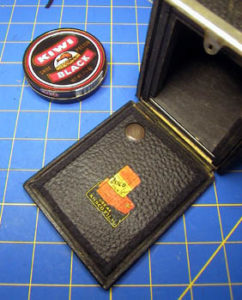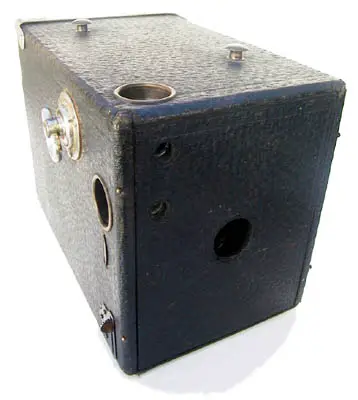- Produced 1903- c 1920 Ansco Corp, Binghamton, NY USA
- Film type 4A rollfilm (will take 120)
- Picture size 6×9
- Weight 15.4oz (436.6g)
- Lens single element meniscus, 3 aperture settings via pull-out tab
- Focal range assume 2m to infinity for most box cameras
- Shutter simple spring w/sliding aperture disc
- Shutter speeds one speed, about 1/60, plus ‘time’
- Viewfinder two ground glass screens (reflectors are polished steel)
- Exposure meter none
Overview
‘What’s this big box on the washing machine?’ I asked. ‘Oh, my coworker and I were talking, and she said she had a big box of broken cameras that she didn’t want any more so I brought them home in case there was anything interesting in there…’ Eh? What? Willing participation in my bad habit? Oh wait, maybe the price tag had something to do with it…. Well, as might be expected, most of the box turned out to be a bunch of nothing, you know the type, old Instamatics and broken Polaroid Land cameras and assorted flashbulb holders, and a couple ancient box cameras, one of which actually worked. So I thought it would be fun to clean it up and test it out, you know, just to see. In fact I was debating whether or not to even make a page about this one, since it’s, well, ‘just another box camera’. But it turns out that it’s different enough, and takes pictures sharp enough, to merit some attention…
It wasn’t much to look at initially, with its strap missing and showing signs of general neglect, but this little black box quickly revealed some secrets. First of all, it’s made entirely of wood. The box is wood, the ‘cone’ is wood, with metal rollers permanently attached during the glue-up. The front of the camera, which I removed to get to the disc shutter and the lens, is actually held on by four tiny nails. Pins, almost. The back is ‘hinged’ simply with the leather the camera is wrapped in, not a metal hinge. And the back locks shut with a metal clasp that covers the rear seam. The simple shutter is a rotating disc with a wire spring, and clicks both on the up and the down stroke. One speed, somewhere around 1/50 I think. A pull-out tab gives three choices of aperture for bright sun, moderate sun, and cloudy. Another tab gives the equivalent of a B setting, though there is no flash sync. No tripod threads either for that matter.
It was made for A4 film, which I’m pretty sure was Ansco’s name for 120, and indeed the comfortable wings that hold the spools easily accept 120 film spools. The frame goes off the film a little but no matter. According to the inside of the camera it was originally patented in 1903, renewed in 1910 and again in 1916, which is about where I’ll place this… somewhere in the 1916 to 1920 range.
And here’s the thing about this camera that got my attention even more than its wood construction – it actually has a really sharp lens! The sample shows how quickly the sharpness fades to distortion and blur at full aperture, but stopped down it’s darn impressive for a simple camera of its age. I like the distortion, it’s kind of dreamy and closer to the way our eyes really see, focused on one spot at a time. Would make a good daytime portrait camera.
Repairs
Cleaned the exterior with Lexol, and the interior with a damp paper towel. Removed the four pins holding the front piece and cleaned the frosted view glass, the viewing lenses, and then used chrome polish on the little metal mirrors. Hit the spindle of the shutter with a spot of that Radio Shack Teflon-impregnated oil and did the same for the shutter release pivot. Also lubed the wind knob shaft with a little grease. Started to clean the lens in place and decided it would be easier to just pop out the snap ring. Dental picks are good for that, and I was right, I was able to clean the lens much more thoroughly once removed. I was suprised to see how rough the edges were, like it was chipped from a larger piece of glass, then ground.
Test roll revealed some light leakage so I added some felt around the inside of the back door:

Then when I went to photograph the camera I thought it looked shabby so I blackened it up with some black Kiwi shoe polish and hit the exposed wood spots with Birchwood Casey Super Black flat black paint pen, I love that stuff. Great for lens interiors!
Tips & Tricks
This shutter is not spring-return, but clicks down for one exposure, then takes another when you click the lever back up. Use a slow film like Plus-X or Ilford HP4 and shoot in daylight. Unless you’re trying to get candids, that is – I haven’t tried to shoot fast film and pull it back, but that might work. 125 ASA in daylight seems to be about right.
This is strictly a handheld camera; there is no tripod mount, no strap lugs, just a handle, er, except on mine. I know I could make one if I wanted to…
Loading film: don’t forget that you need to pull out the film wind knob before you can get the ‘cone’ out. One side of the cone actually says TOP but you could probably figure out how it goes back by where the opening for the wind knob is.
Related Links
- Box Camera 101 – a must
- Page specifically about old Ansco film types and modern equivalents
- An insider’s view of Agfa-Ansco (PDF) from one who lived it, the late Ira Current. Fascinating…
